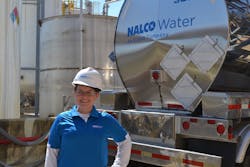Applying Digital Twins to Sustainability
In late 2022, Ecolab and Siemens announced a partnership to develop a digital twin program called Climate Intelligence, powered by EcoLab3D and Siemens gProms. Two pilot programs using this technology are currently underway and the companies say the early results of the venture are showing “tremendous promise” in reducing carbon emissions. They report that the program exemplifies how data and connectivity can help companies reach sustainability goals while balancing productivity and profitability.
Climate Intelligence is a priority for Ecolab and Siemens, with both participating in discussions featuring the program at Davos, COP 27 and the 2023 UN Water Conference. The companies estimate that there is a potential to reduce 25 million tons of carbon each year using digital twin technology. A first full-scale, global, multi-site corporate roll-out will go live in 2023 for a major chemical processing company. More news on that is expected soon.
In the meantime, Automation World connected with Neil Davidson, a director within the downstream division of Nalco Water, an Ecolab company, and Sterling Allen, director of business development for Siemens Process Systems Engineering, about the two companies' partnership and how the digitization of operations is a meaningful step that industries can take, even while determining other long-term decarbonization strategies.
Q. How did the Ecolab-Siemens partnership come about and what is the role for each company?
We quickly identified digital tools as an indispensable component in addressing the challenge, leading us to evaluate potential digital technology companies for a partnership. Siemens Process Systems Engineering emerged as the perfect fit due to their expertise in digital twin technology, customer-centric approach, and dedication to the decarbonization of industrial processes. Consequently, the partnership was born and Climate Intelligence emerged. This collaboration leverages Ecolab's deep industry expertise and broad footprint in the water industry, coupled with Siemens' digital capabilities. Together, we aim to create a robust, effective solution for decarbonization.
Q.How is digital twin technology being used in this program?
Allen: Digital twin technology has shown immense potential in supporting industrial companies’ sustainability efforts. By creating a virtual replica of a system or process, companies can simulate, predict and optimize their operation. This leads to better resource utilization, increased efficiency and decreased waste. The reason for the improvements that customers experience is improved decision making. The advanced solvers in gPROMS deliver easy-to-follow recommendations for optimization of complex multivariate systems. When our customers see the results from a validated process model compared with actual plant data, they are able to trust the system and rely on its recommendations for improved decision making. Not only does this contribute to their sustainability efforts, but it also boosts their bottom line, demonstrating that profitability and environmental responsibility can coexist.
Davidson:Digital twin technology can act as an immediate step towards sustainability that industries can adopt, even while they are formulating long-term decarbonization strategies. Climate Intelligence pilots have shown that the technology can facilitate approximately a 5% overall reduction in emissions and pays for itself through efficiency gains.
Q. Can you provide some specific examples of how digital twin technology can boost efficiency and sustainability?
Davidson:In one pilot, we were able to address issues with high-risk boilers suffering from poor condensate recovery. By using the digital twin, we could quantify the repercussions not only in terms of operating costs, water losses, wasted energy and additional emissions, but also how it limited production. The digital twin provided us visibility into these complex interactions, allowing us to mitigate problems before they severely impacted operations.
In another pilot, the digital twin of a cooling system revealed that the customer was excessively cooling one area of their plant, leading to product quality issues. We were able to quantify the impact of rerouting some of this excess cooling energy elsewhere. This seemingly minor adjustment could result in several additional tons of ethylene production per hour without any additional emissions. This cooling digital twin, which is the first of its kind, allows us to connect cooling water performance to production outcomes. This enables us to tune the cooling water to best serve low-emissions production and also enables us to quantify the opportunity gap in near real time. These cooling systems are incredibly dynamic, especially in different weather conditions and times of day, which is why digital twin technology is so important.
Q. What industries is Climate Intelligence aimed at?
The preliminary results from the pilot programs have been encouraging. A pilot conducted in a mid-size refinery showed a potential reduction of about 40,000 tons of carbon emissions per year and an estimated savings of $1.8 million. The pilots have now concluded and we are implementing projects across diverse geographic regions, including Asia, the Middle East, Europe, USA and Latin America. While the emphasis continues to be on refinery and petrochemical customers, we have started engaging with customers in the power sector as they have expressed interest.
Q. How is Climate Intelligence different from other decarbonization systems or programs?
Davidson: Climate Intelligence differentiates itself from other decarbonization solutions in several ways. First, we understand from our customers that they face resource constraints when trying to implement sustainability solutions. With Climate Intelligence, we help alleviate the burden by taking full responsibility for the design, build, execution and service of the program. We handle the technicalities and complexities of the solution so that our customers can enjoy the benefits and outcomes while remaining focused on running their plants efficiently, safely and with minimized emissions.
Second, we bring a unique perspective on water into Climate Intelligence, which is often overlooked in decarbonization efforts but holds significant value. Our customers understand the impact climate change could have on their operations. However, they often lack the insights and time to adapt to these changes quickly. In some instances, they might be hesitant to adjust due to concerns about potential reliability issues, such as loss of cooling availability or steam contamination. This is where we excel. Our deep understanding of water and its risks, combined with the capabilities of Climate Intelligence, allows us to deliver critical insights via digital twin technology 24/7/365, enabling our customers to manage these changes and challenges effectively.
Q. Where does Climate Intelligence fit into Ecolab and Siemens’ existing services?
Davidson:Climate Intelligence is part of the EcoLab3D suite of digital solutions that is included in the services to customers who use this technology. It builds on what we have been doing for over 95 years—conserving water and energy and optimizing production through smart use of cooling and steam systems.
Q. Is Climate Intelligence customizable for different industries?
Allen: Climate Intelligence is a highly adaptable and customizable program that can accommodate different industries and scales of operations. It is designed to be simple and accessible for companies to adopt and start using. The fundamental principles and chemistry involved in the use of cooling water and steam are applicable across different industries. The desired outcome—enhancing efficiency by achieving more with less—remains a common goal across sectors. While the specific energy and water needs may vary depending on the particularities of a company's manufacturing process, and regional differences related to cooling water might exist, the overall approach of Climate Intelligence can be effectively scaled to different industries.
Davidson: We’ve made the onboarding process for users as simple as possible. Initially, we conduct an assessment that takes about a week, during which we determine the potential benefits of using Climate Intelligence and establish the baseline performance conditions. If the customer is satisfied with the projected benefits, we move on to the next stage of creating the site's water-energy blueprint, which is essentially the offline digital twin. Once the offline model is validated and agreed upon with the customer, we then transition to the commissioning phase to establish a live model. Our service teams provide support to the end users throughout this process.




